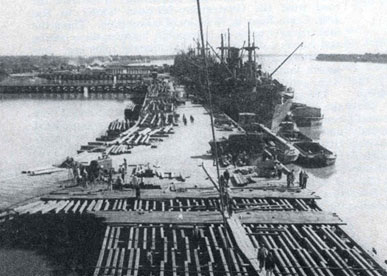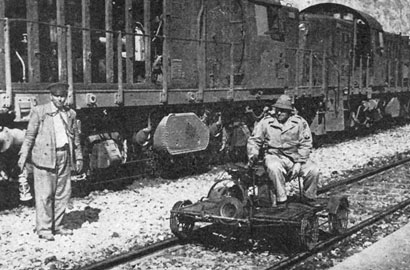Engineer Construction in the Persian Gulf Provided a Key Lifeline During World War II
 |
| Teak logs were spliced and driven as pilings |
Following the Nazi invasion of the Soviet Union in the summer of 1941, the British and Soviet governments established a joint occupation of the Middle Eastern nation of Iran that lasted the duration of World War II. Engineer officer Col. Raymond A. Wheeler (later Chief of Engineers) led the U.S. Military Iranian Mission, established in September 1941, to facilitate lend-lease supply to the U.S.S.R. At this same time, the Iranian District of the North Atlantic Division was set up to provide construction support. In August 1942 the mission was re-designated as the Persian Gulf Service Command and in December 1943 became the Persian Gulf Command. It subsequently came under the command of a succession of engineer generals. Following the War Department’s full militarization of construction, the Iranian District ceased to exist in May 1943. Three districts directly subordinate to the area command eventually replaced it.
Troops of the command faced immense challenges. In this part of the Middle East, engineers transported supplies through rugged terrain that ranged from desert to snow-packed mountains and had to operate equipment in temperatures from below zero to more than 120 degrees F. Supplies headed northward were shipped to the ports of Ahwaz, Khorramshahr, and Bandar Shapur, Iran and Basra, Iraq. Army engineers expanded these ports using easily obtainable materials, such as imported Indian teak logs to form pilings. Cargo in flatcars or in trailers known as “lowboys” were removed from Liberty ships at an astonishing pace. During the summer of 1943, a friendly off-loading competition broke out between troops of a white battalion and that of a black unit—in a single 24-hour period one company of black troops off-loaded 980 long tons of mixed freight. Soon another company broke the world’s time record for off-loading a Liberty ship. At one point, Khorramshahr became the world’s third busiest port in terms of tonnage handled.
 |
| A dock pressed into service before completion |
From these ports, engineers constructed inland roads. The principal project was the main highway that extended from Khorramshahr to Kazvin. In the southernmost section, the civilian contractors Folspen (Foley Brothers and Spencer, White, and Prentis) began work and laid a 24-foot-wide highway that sloped upward. Given the lack of adequate base materials, the southern section consisted of an earthen embankment compacted with sheep's foot rollers. Suffering recurrent washout, this section was completed only after the arrival of the 352d Engineer General Service Regiment, a black unit. With a shortage of concrete, the subgrade of the road’s entire length was sealed with asphalt and overlaid with a 2-inch layer of soil asphalt. Of note, many of the roadbed sections that were improved were originally constructed in ancient times by Alexander the Great or Persian King Darius.
In conjunction with British troops and Iranian civilian labor, the 334th Engineer Special Service Regiment began construction concurrently on the Andimeshk-Malayer highway and on a large reservoir near one terminus. An ingenious use of materials overcame the difficulties of working in this area, where the ascent could be as much as 12 percent in places. For bridges, the command engineers used steel beams salvaged from the demolition of the Sixth Avenue elevated transit line in New York City. The bridges, along with the attendant concrete abutments, piers, beams, and 26-foot-wide deck slabs, were designed to fit these beams and not necessarily the terrain on which they were being built.
The 711th Engineer Railway Battalion, stood up at Fort Belvoir and comprised of recruits from the rail industry, was the first such unit deployed overseas when it arrived in Iran. The railway was integrated into the backbone of the Iranian supply line. It was a daunting task, as noted by one observer who said, “It’s as though you suddenly had to serve all of Greater New York with the Coney Island scenic railway.” The professionals in this unit were wildly successful in getting their 90-ton “Mike” locomotives (originally designed at the turn of the century for the Japanese Emperor, a.k.a. the Mikado) to the Soviet border. This unit’s construction activities dramatically increased the Iranian State Railway’s capacity; in July 1944, 7,520 tons of equipment were moving northward daily. In fact, oftentimes the Soviet Union received tonnage that exceeded original requests several times over. Occasionally the command sent some of these rail troops to assist the Soviets when sections of their tracks north of Tehran would wash out.
 |
| A soldier on a track car tests for possible trouble on the Iran route |
The Persian Gulf Command built other structures in support of its major tasks. Engineers constructed vehicle assembly plants at Khorramshahr to piece together cased motor trucks shipped from the U.S. They also built 44 airstrips. The command’s headquarters facility alone, at Amirabad near Tehran, contained barracks facilities for more than 3,000 troops. In the end, more than 30,000 Americans served with the Persian Gulf Command. At war’s end, the Persian Gulf Command reverted to a service command, which itself closed at the end of 1945. The organization had engaged in construction work valued at $100 million and allowed for the transshipment of four and a half million long tons of materiel, almost 5,000 airplanes, and 184,000 vehicles to the Soviet Union.
* * *
February 2003